Part 1 The Early Days
I grew up in and around the beaches in Southern California surfing, skating, and riding BMX.
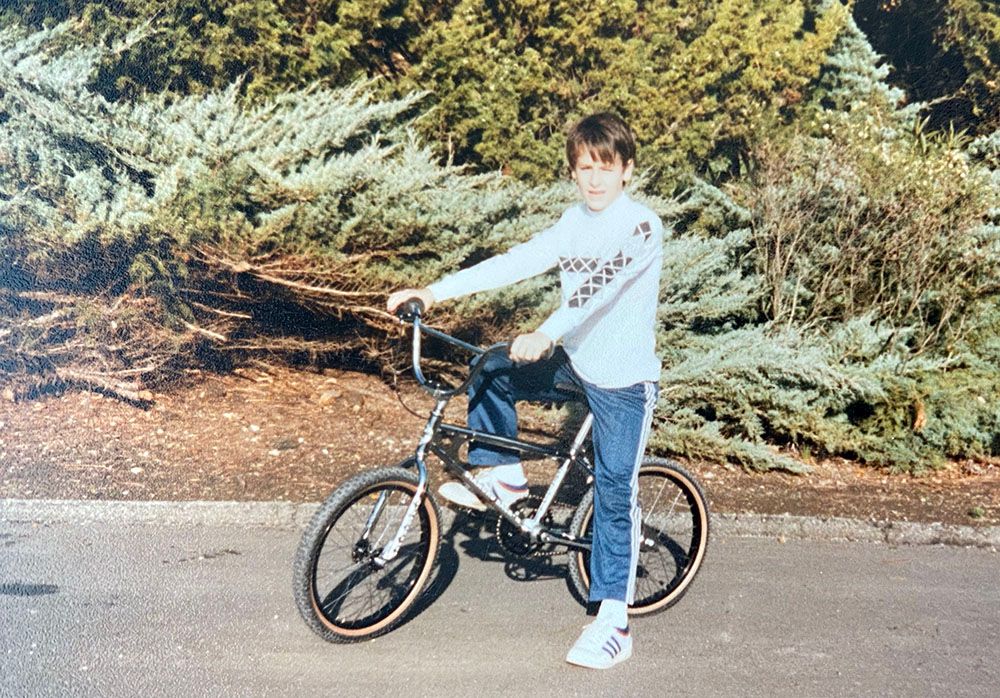
We relocated to Silicon Valley for high school, where I landed my first job at the first flagship retail store for The North Face in Palo Alto. Legendary Climber Paul Gagner was the manager, and my first introduction to climbing was on a work trip to Yosemite Valley. I didn't know it at the time, but that excursion became a transformational launching pad, rocketing me deeper into the world of action sports. I spent many a day during the summers on the sharp end of the rope in Yosemite Valley culminating in many ascents of classic lines and big walls. Of note, this would not be my first interaction with the North Face Brand.
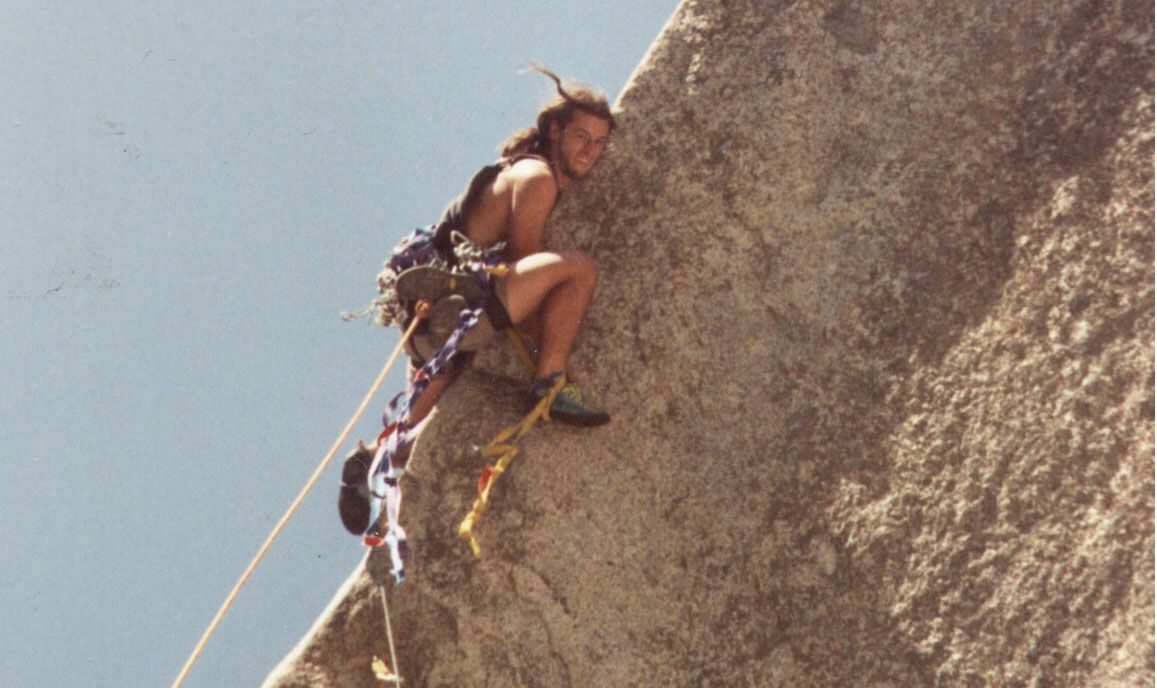
You learn a lot about yourself and your ability to handle dangerous situations when runout 20-30 ft above your last traditionally placed anchor. Spending time in the vertical world helped me work through my fear of heights (yes, you heard that right, I used to be afraid of heights!) using the exposure of the walls as a mental problem to address and work through. During the winters, Skiing took a back seat to Snowboarding (fulfilling my jonesing for surfing) with my first day on a snowboard in 1986. Then, duct-taped Sorels with a Sims or Burton board was considered high-tech.
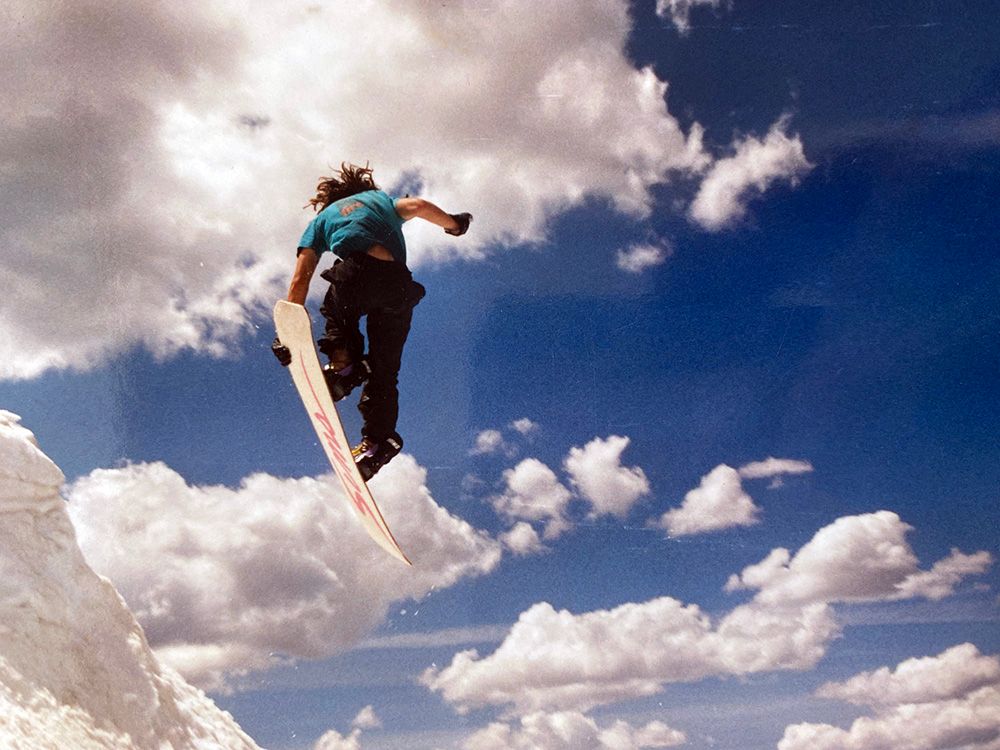
The summer after high school, I attended an intensive 30 day Alpine Mountaineering & Technical leadership Course at the American Alpine Institute in Bellingham, Washington. As a result, I acquired foundational skills which have saved my life on more than one occasion, and I still use them in many facets of my life.
A winter trip to Tahoe turned into 12 years in Squaw Valley to pursue big mountain riding. I earned the title "Lord of the Boards" by mastering the 3 disciplines of Skiing, Snowboarding, and Telemarking. I actively competed in various events such as The inaugural Lord of the Boards, the Big Mountain Extreme Ski/Snowboard Tour, the Swatch World BoarderCross Tour, and the ESPN UltraCross.
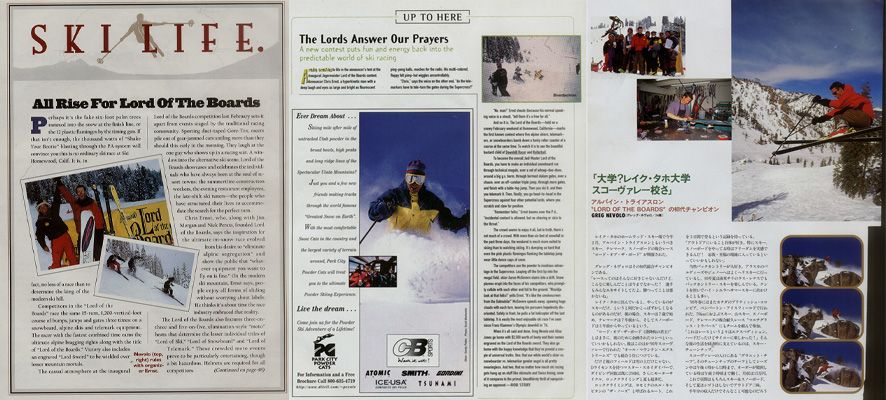
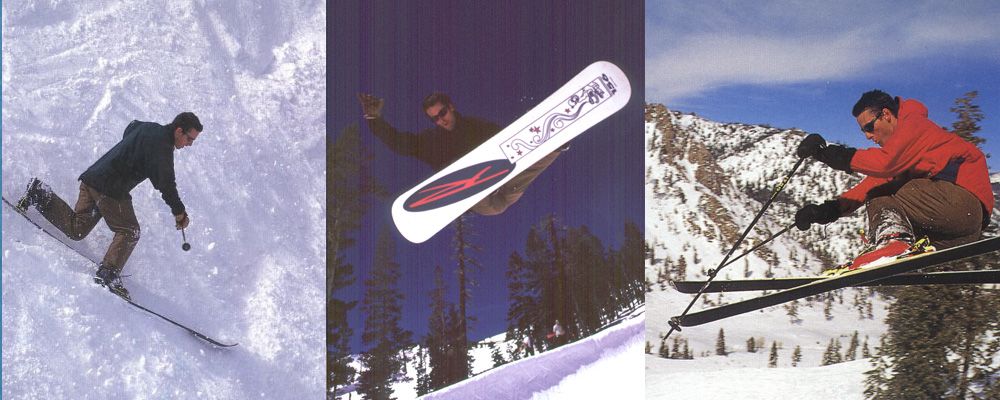
However, after suffering a knee injury in an avalanche, my competition dreams were put on hold, and I switched to the production side. After watching the carnage and injuries to the Ski athletes at the First X-games at Snow Summit, I knew there could be a better way to design the courses, as in, actually design the courses.This led to me playing a pivotal role in producing and developing the SkierX events at the ESPN Winter X-Games from 1998 to 2003 at Crested Butte, Mt Snow, and Aspen. I was the head course designer operating the Snow Cats and using the mountain as a creative canvas for building jumps, berms, and rhythm sections. Eventually, Ski Cross made its Olympic debut as a medal sport at the 2010 Olympic Games in Vancouver-Whistler.

This was a great time to be based in Squaw Valley living the ski bum life (as featured in Rolling Stone!) with Skiing and Snowboarding cultures evolving and influencing one another at a blistering pace. It was ground zero for snow attracting many athletes from around the world. It was a simpler time when the only thing that mattered was arriving early on a POW day to line up for the Original KT-22 Double Chair to slay your favorite lines. One of the best features was riding the chair up over the "Fingers" and watching all the wannabe Hucksters putting on a show as they jump and navigate rocky lines to flat landings. One of the import Bros coined the term "Squallywood" and created a book similar to a climbing guide which is still fitting today. KT-22 is now a 6-pack and affectionally named the "Mothership" because you can do 6 laps per hour riding epic terrain. There really is nowhere else quite like it. And oh, the Corporate Woke Culture thought it would be good to change the name from Squaw Valley to Palisades Tahoe since 2 people somewhere were offended by the Squaw name (I'm joking). IMO it might have been better to pay Homage to the first Olympics and just name it after the Valley it sits in "Olympic Valley." To us, it will always be Squaw.
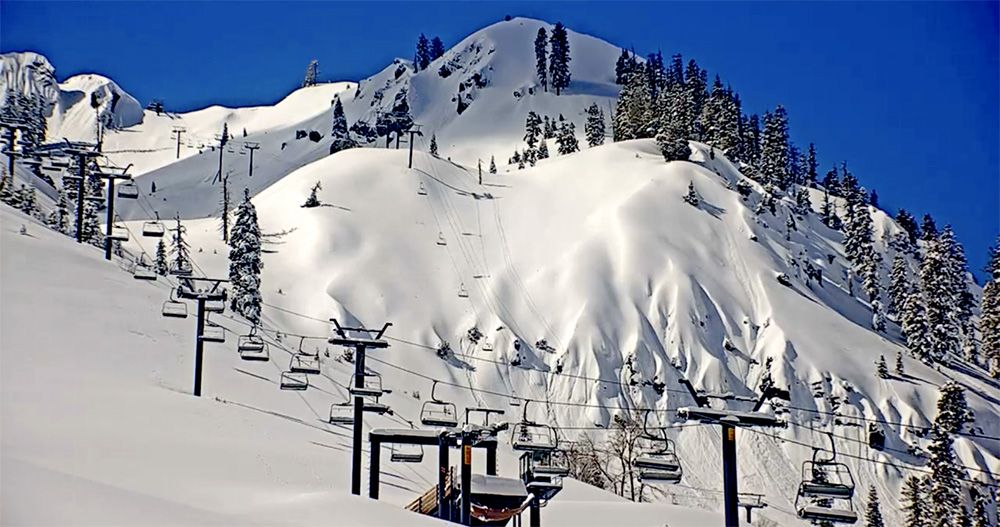
I was fortunate at the time to be able to explore SE Alaska in the early heli-skiing days around Valdez and Juneau. These were self-guided runs where you would tell the pilot which peak you wanted to ski. In exchange, you would fork over a pre-purchased poker chip based on the distance from the LZ. This combined every skill I had at the time: Big mountain riding, mountaineering, route finding & Self-rescue. The experiences became another transformative point in my life - and I'm not talking about an early descent of The Ramp on Meteorite peak which we nailed before the big avalanche; I'm referring to my love of flying (more on this later)...
In 1993, I was introduced to skydiving indirectly while climbing the Mega-Classic Nose Route of El Capitan. We spent the night on the Top of El Cap Tower and were politely awoken by several BASE jumpers rocketing past at 4 am during the full moon. I looked at my climbing partner at the time and said, "They are having more fun than us! we are going to have to try that".... 2 weeks later, I completed my AFF course in 3 days at Skydance Skydiving in Davis, followed up with my first BASE jump a week later off the Jolly Green Giant in Auburn. I was quickly indoctrinated early into the Freeflying days, Swooping, and BASE disciplines by having world champion friends in the sport from Mike Vail, Charles Bryan, & Olav Zipser for skydiving to Adam Filipino, Martin Tilley, and Frank Gambalie for BASE.

Tapping into my self-promotion skills from winter sports, I landed a spot on SoBe's Adrenaline Rush team. I performed many demonstrations & stunt jumps into high-profile sporting events, such as the NBC Gravity Games, AMA Motocross Outdoor Nationals, and the Burton US Open of Snowboarding.
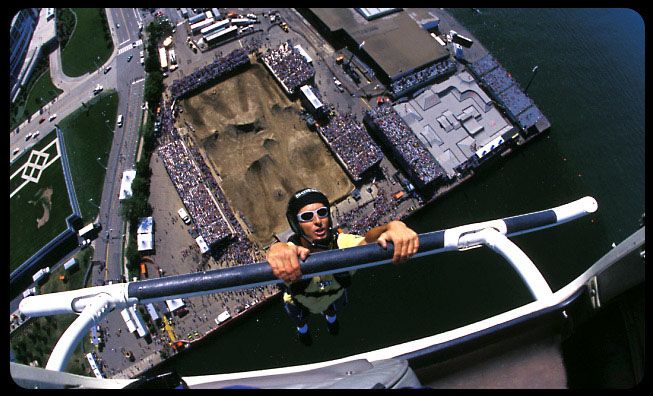
Two of the more remarkable projects I worked on were for iconic players in the action sports scene. The first was for the Fleshwound Films Crusty Demons of Dirt series, which served as the vehicle for capturing and promoting the early freestyle motocross scene. I developed the opening scene for the 3rd installment, which ended up being the first time anyone rode a dirt bike out of an airplane.
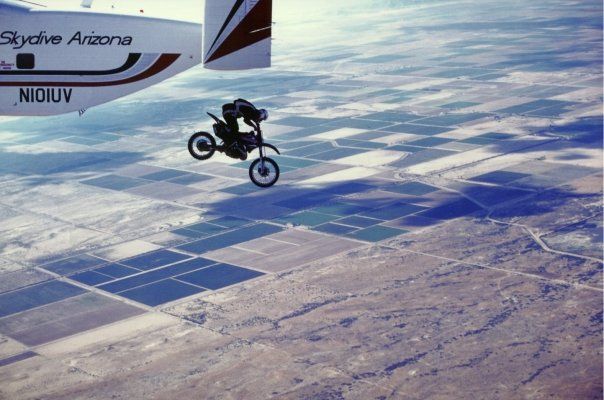
The second, I was doing some dream work for the music band The Offspring. I was the stunt coordinator and stunt-double performer in multiple segments in their video album "Huck It" (Conspiracy of One) and the earlier Americana music video. The video album was a first-of-its-kind Music, Video & Action Sports mashup released by a Major Record Label. I tapped in quite a few friends to help out with these ones, including accomplished Skydiver & Stuntman Alaska Jon Devore & Pro-Snowboarder Jim Rippey. This was incredibly rad since The Offspring revived punk rock in the 90s (more pop-punk) and were synonymous with Action Sports & Southern California. In addition, the lead singer Brian (Dexter) Holland is an accomplished fixed-wing pilot in his own right.

As time went by, BASE jumping became my primary passion. Once again, my timing for entry into a sport was impeccable, with better (and safer) gear coming online. My BASE journey started with velcro-closure rigs (Gravity Sports) and non-base-specific skydiving reserve canopies like a fury 220 (way undersized). Then, it evolved to Double Pin Rigs and Base Specific Gear built by Adam and Marty, to name a few. This progress accelerated what was possible to do safely in the BASE world. In addition, the new generation of jumpers and manufacturers like Squirrel, owned by Mattt Gerdes and Mike Steen, are taking the sport to new frontiers unlocking amazingly long flights and new exit points with their engineering approach to gear design. Over the next decade, my travels would take me to other continents and killer locations, looking for new lines and ways to test my skills from Moab to Lauterbrunnen to Chamonix to Kjerag.

Looking back, it's easy to see why. BASE jumping is the ultimate feeling of being present in the moment. It requires 100% focus, concentration, and commitment. Other sports had similar experiences though not quite as intense, like being runout on the sharp end of the rope, getting barreled while surfing, and your next turn in the you-fall-you-die skiing line. What I really enjoy the most is the science and art of risk assessment. Breaking down the challenge into smaller components, weighing and comparing the variables, making an informed decision, and committing without hesitation. Anything seems off, turn around and live to jump another day.
As an old-timer pilot once told me, Takeoffs are optional, Landings are Mandatory.
Onwards to Part 2: TAKING FLIGHT: A new millennium begins
